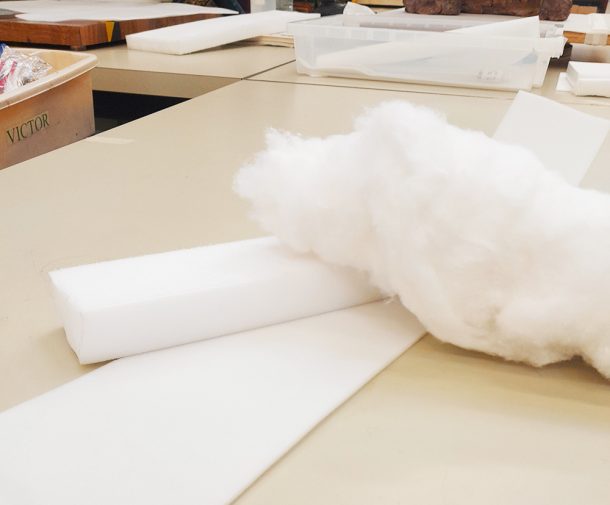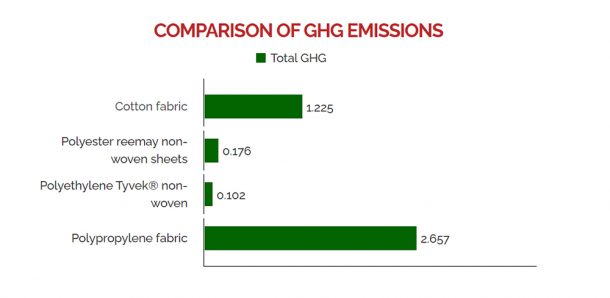In the conservation department at the V&A, choosing materials for conservation work is rarely a straightforward process. Materials are commonly chosen based on their properties and their ability to stabilize an object in the long-term, without permanently altering or affecting it. The Oddy Test – a scientific test of whether materials will release potentially hazardous gases over time, developed at the British Museum in 1973 – is one of the primary tools used by conservators to determine if a material is appropriate to use with cultural heritage objects. The very thing that can make a material “conservation-grade” according to the Oddy Test can also be the thing that makes it tricky to replace with a more sustainable option. For example, many conservation materials that pass the Oddy Test are used because they will not degrade over time, a necessity for things like mounts and protective covers that must remain chemically inert (don’t react with or change the objects they touch) and protect objects without falling apart. This often means that these materials are very difficult to recycle, or are not biodegradable, which can be a challenge regarding sustainability once they are no longer in use. Looking at how materials are sourced, different ways they can be used and different methods for determining suitability for conservation are important steps in reducing waste and the harmful environmental impact that some conservation materials can have.

Before choosing a material or tool for use, conservators must decide whether it both fits the constraints of their conservation activities, and is sustainable and responsibly sourced. One of the challenges in assessing materials and tools for sustainability is the sheer number and variety used by conservators. It is difficult to compare materials such as gels, solvents, packing materials and display materials as the scarce information about these materials requires hours of research and many of the products are labelled in misleading ways, otherwise known as “greenwashing”. The Foundation for Advancement in Conservation (FAIC) is working on creating a Life Cycle Assessment Tool (LCA) for museum and heritage professionals, a database that would allow conservators to search and compare the impact of items ranging from gloves, to packing, to pest management. The Oddy Test is a useful tool currently available for determining if a material will be safe to use for an object, however more sustainably sourced materials, such as those made from 100% recycled materials in many cases do not pass the Test due to their risk of emissions. This means that the number of sustainable, Oddy-approved materials available to conservators are limited.

In the meantime, there are some resources that conservators can use in order to inform their practice, such as the Greener Solvents in Conservation Handbook, available as a free download from Sustainability in Conservation. Through the steps outlined in the handbook conservators can assess the chemicals they use and where possible find more sustainable replacements. Another resource is the Carbon Calculator from STiCH, a free online tool that allows conservators to compare the carbon footprint of materials according to the amount they are using. These tools can be used on materials that pass the Oddy test to ensure that among the choices available, the most sustainable option is used. Conservators are also finding ways to use conservation-grade materials in innovative ways. It has been found that Evolon, a highly absorbent microfilament fabric, can be used to apply liquids to surfaces instead of cotton swabs. The benefit of this is that Evolon can be dried and reused, and is made of fully recyclable polyester and polyamide. Using Evolon in the place of single-use cotton swabs for liquid applications not only reduces cotton waste but has the potential to reduce the environmental impact of conservation activities early in the supply chain, as cotton requires large amounts of water to produce as a crop and it can be difficult to ensure socially sustainable sources.
The question of how to prioritise environmental sustainability and object safety in materials choices does not have a clear answer. There are many ways in which conservators attempt to meet the requirements of both, but ultimately more research needs to be done into how to create a system that appropriately weighs environmental impact against the requirements of long-term object preservation.



I am glad to see this subject broached. Yes, we need to face the reality that cotton production is resource-intensive. I am also hesitant to adopt a synthetic material like Evolon as a substitute for an organic and more quickly-decomposing material like cotton. For other reasons, Evolon is an infrequent choice in my studio: Evolon’s high absorption rate poses risks to some painting materials; Evolon has been found to deposit residues and one must plan a treatment to accommodate this; Evolon is reusable (it can be washed) but it is not recyclable in the same way that newspapers and metal cans are recyclable. We need to keep coming up with creative solutions to this problem. This is a valuable and necessary discussion; thank you for starting it.